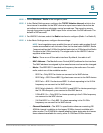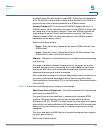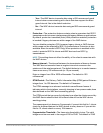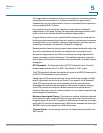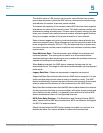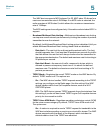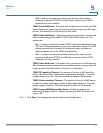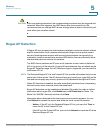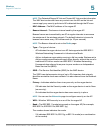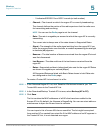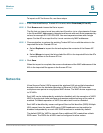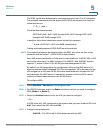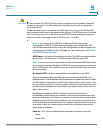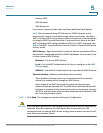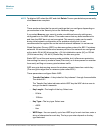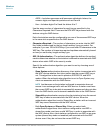
Wireless
Rogue AP Detection
Cisco Small Business WAP551 and WAP561 Wireless-N Access Point 67
5
NOTE The Detected Rogue AP List and Trusted AP List provide information.
The WAP device does not have any control over the APs on the list and
cannot apply any security policies to APs detected through the RF scan.
• MAC Address—The MAC address of the rogue AP.
• Beacon Interval—The beacon interval used by the rogue AP.
Beacon frames are transmitted by an AP at regular intervals to announce
the existence of the wireless network. The default behavior is to send a
beacon frame once every 100 milliseconds (or 10 per second).
NOTE The Beacon Interval is set on the Radio page.
• Type—The type of device:
- AP indicates the rogue device is an AP that supports the IEEE 802.11
Wireless Networking Framework in Infrastructure Mode.
- Ad hoc indicates a rogue station running in Ad hoc mode. Stations set to
Ad hoc mode communicate with each other directly, without the use of a
traditional AP. Ad hoc mode is an IEEE 802.11 Wireless Networking
Framework also referred to as peer-to-peer mode or an Independent
Basic Service Set (IBSS).
• SSID—The Service Set Identifier (SSID) for the WAP device.
The SSID is an alphanumeric string of up to 32 characters that uniquely
identifies a wireless local area network. It is also referred to as the Network
Name.
• Privacy—Indicates whether there is any security on the rogue device:
- Off indicates that the Security mode on the rogue device is set to None
(no security).
- On indicates that the rogue device has some security in place.
NOTE You can use the Networks page to configure security on the AP.
• WPA—Whether WPA security is on or off for the rogue AP.
• Band—The IEEE 802.11 mode being used on the rogue AP. (For example,
IEEE 802.11a, IEEE 802.11b, IEEE 802.11g.)
The number shown indicates the mode:
- 2.4 indicates IEEE 802.11b, 802.11g, or 802.11n mode (or a combination
of the modes).



